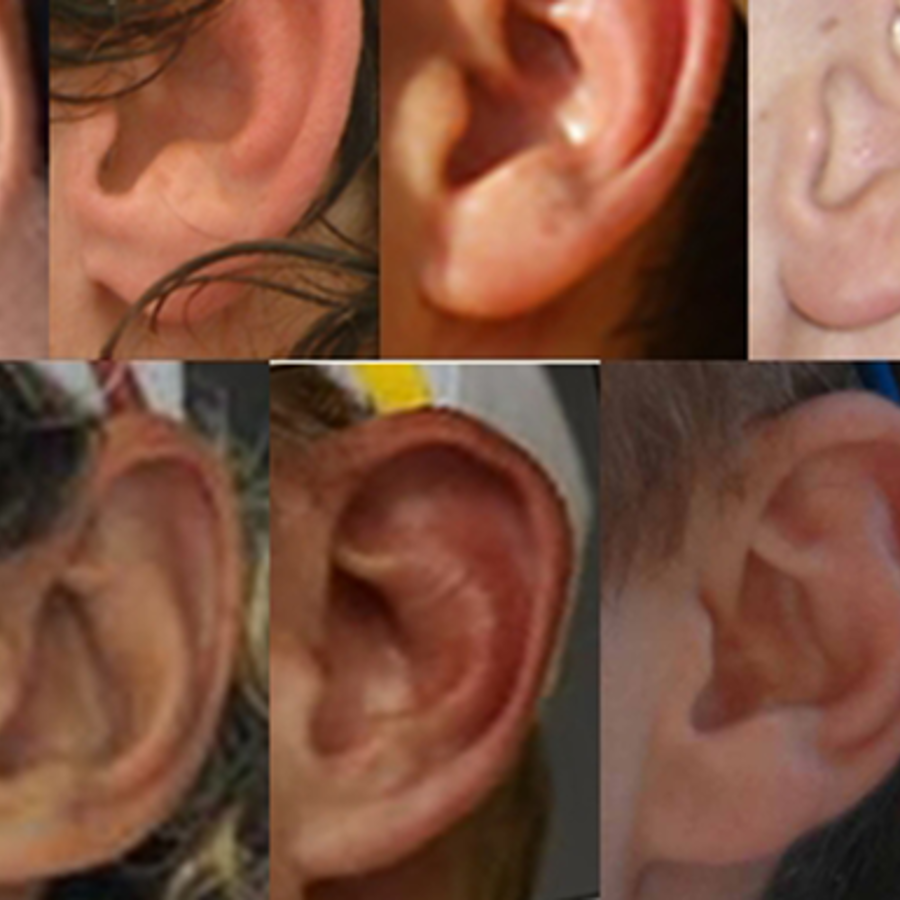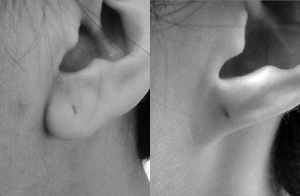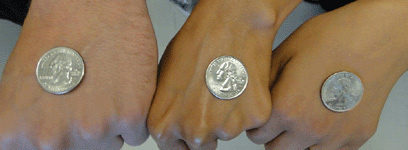
How can parents with attached earlobes have a child with unattached?
August 4, 2010

- Related Topics:
- Genetic myths,
- Editor's choice,
- Dominant and recessive,
- Complex traits,
- Common questions
An undergraduate from California asks:
“So, everyone in my family has attached earlobes yet I came out with unattached earlobes. Why is that?”
Sounds like you listened to your high school biology teacher about earlobe genetics. Or did some research on your own.
Your teacher and just about everything on the web says that parents with attached earlobes can't have kids with unattached ones. And they're all wrong.
Most everyone presents earlobe attachment as a very simple trait. (We've even fallen into this trap here.) But it's not. Even though earlobe genetics hasn't been studied a whole lot, the little bit that has been done shows it is pretty complicated.
This means that it isn't uncommon for parents with attached earlobes to have kids with unattached lobes. Or even for parents to have kids with one attached and one unattached earlobe!
So what's going on here? Is there a vast conspiracy to make some people worry? Probably not.
There is a seed of truth to everything out there on the web. Early studies did create a model where parents with attached earlobes couldn't have kids with unattached ones. It is just that people probably didn't hear about the later studies that showed that this wasn't the case.
What I thought I'd do for the rest of the answer is go over the history of earlobe genetics. I'll talk about why scientists thought what they did at first and then what caused them to reverse their thinking. To discuss all of this, we need to first step back and talk about dominant and recessive traits.

Genes Are Like Recipes
Most of us know that we get half our DNA from our mom and half from our dad. This DNA has long stretches in it called genes.
Each gene is a set of instructions for one small part of us. So all the genes in our DNA together have enough information to make an entire human being.
Now here's something interesting: we all have almost the exact same set of genes! Which might make you think that everyone should look identical. But we don't, of course. So what's going on?
Although we all have the same set of genes, we can have different versions of some of them. These different versions of the same gene are called alleles. And it is these different alleles that make each of us unique.
Imagine an oatmeal cookie recipe. Some people have a recipe for an oatmeal cookie with raisins and some people have one with chocolate chips. But they're both still oatmeal cookie recipes.
Same thing with genes. For example, there is a hair color gene that comes in two versions, red and not-red. Which alleles you get determine whether you'll have red hair or not. Just like which recipe you use determines if you'll have raisins or chocolate chips in your oatmeal cookie.
Gene Versions That Dominate
Remember, we get a copy of each gene from our mom and a copy from our dad. So our bodies take the two versions of every gene and follow each set of instructions.
Sometimes, the instructions go together and we can see the result of both. If you mix a recipe for oatmeal chocolate chip together with one for oatmeal raisin, you'll get oatmeal chocolate chip raisin cookies.

Sometimes, though, one allele of a gene dominates the other. This is just like when we mix a chocolate cupcake recipe together with a vanilla one and get a chocolate tasting cupcake. Even though both recipes were made, chocolate wins out.
The hidden gene version is called the recessive allele. So if you get a dominant allele of a gene from one parent and a recessive allele from the other, you'll only show the dominant trait. Even though the recessive one is still in there.
This is how earlobes were thought to work. Often the kids of one parent with attached and one parent with unattached earlobes will all have unattached earlobes. Because unattached was thought to be dominant.
But unlike cupcakes, the dominant version doesn't seem to always win. Sometimes you'll end up with a recessive trait even if one of your parents has a dominant one. Sometimes chocolate +vanilla = vanilla.
To understand why this is, we need to remember that we have two copies of each of our genes. Sometimes someone with a dominant trait has a hidden recessive allele. If they pass that on (and the other parent does too), then the child will have the recessive trait.
So for earlobes, imagine a parent with an attached and an unattached allele. This parent will have unattached earlobes but could pass the attached allele to their child. That child might end up with attached earlobes.
Of course, given all of this, two parents with a recessive trait can't have a child with a dominant one. So two parents with attached earlobes should not be able to have a child with unattached ones.
Except that sometimes they do. Which means that earlobes are more complicated than is usually advertised.
Ear Lobe Studies
In one of the first earlobe studies, scientists concluded that unattached earlobes were dominant over attached ones. They based this on two families.
Everyone in the first family had attached earlobes and everyone in the second had unattached ones. When a man from the first family married a woman from the second, all six kids had unattached earlobes.
But in lots of follow up studies, this result didn't hold up anymore. Sometimes parents with attached earlobes had kids with unattached earlobes. So the scientists concluded that earlobe inheritance must be more complicated than they initially thought. And that it might even involve more than one gene.
Why the different results? There are at least a couple of reasons.
The first explanation is actually something you may already know -- things often happen by chance. If you flip a coin three times, the chances of them all being heads is high enough that you might bet on it. However, few people would bet on having 100 coin flips all be heads. This is because even though the chances of any one coin flip being heads is 50-50, the chances of 100 of them doing so are much less than this.

What if something similar is going on for earlobes? Imagine that earlobes often followed a simple dominant/recessive pattern. But not always. Maybe one in every 100 people would have unattached earlobes when his or her parents both have attached ones.
If we look at only a dozen people, we are likely to miss this. We might conclude that earlobe inheritance is simple and predictable based on genetic rules of dominance. And we'd be wrong.
The second issue with the initial studies is that they looked at only two families and the children from the marriage. People that live in the same regions of the world often share many of the same alleles. And members of the same family share even more.
So it could very well be that in the family they studied unattached earlobes were dominant because everyone shared the same set of alleles. But a more diverse set of people may follow a different pattern because they have different alleles.
It could also be that there are different ways to end up with attached and unattached earlobes. Sometimes they work in a simple dominant/recessive way and sometimes they don't. The scientists happened to study a couple of families where the simple explanation was right.
Exceptions to the Rules
So there you have it: it isn't actually surprising or uncommon for parents from families with attached earlobes to have a child with unattached earlobes. What is more surprising is that the old data has hung around for so long and that everyone has ignored the more recent data.
We simply do not yet understand how earlobe attachment is passed down. And we probably won't for a long time. This is not a problem keeping scientists up at night!
A word of caution though. Even if earlobe attachment were a simple dominant/recessive trait, there still would be rare exceptions. Nothing in genetics is 100%; there are exceptions to every rule!
Read More:
- John McDonald from the University of Delaware has a great site dedicated to genetic myths like this one!

Author: Diane Wu
When this answer was published in 2010, Diane was a Ph.D. candidate in the Department of Genetics, studying post-transcriptional gene regulation in Andy Fire’s laboratory. Diane wrote this answer while participating in the Stanford at The Tech program.
 Skip Navigation
Skip Navigation
